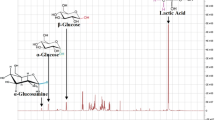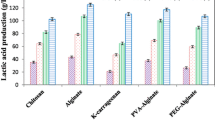Abstract
Production of lactic acid from glucose by immobilized cells of Lactococcus lactis IO-1 was investigated using cells that had been immobilized by either entrapment in beads of alginate or encapsulation in microcapsules of alginate membrane. The fermentation process was optimized in shake flasks using the Taguchi method and then further assessed in a production bioreactor. The bioreactor consisted of a packed bed of immobilized cells and its operation involved recycling of the broth through the bed. Both batch and continuous modes of operation of the reactor were investigated. Microencapsulation proved to be the better method of immobilization. For microencapsulated cells at immobilized cell concentration of 5.3 g l−1, the optimal production medium had the following initial concentrations of nutrients (g l−1): glucose 45, yeast extract 10, beef extract 10, peptone 7.5 and calcium chloride 10 at an initial pH of 6.85. Under these conditions, at 37 °C, the volumetric productivity of lactic acid in shake flasks was 1.8 g l−1 h−1. Use of a packed bed of encapsulated cells with recycle of the broth through the bed, increased the volumetric productivity to 4.5 g l−1 h−1. The packed bed could be used in repeated batch runs to produce lactic acid.




Similar content being viewed by others
References
Akerberg C, Zacchi G (2000) An economic evaluation of the fermentative production of lactic acid from wheat flour. Bioresour Technol 75:119–126
Amrane A, Prigent Y (1999) Differentiation of pH and free lactic acid effects on the various growth and production phases of Lactobacillus helveticus. J Chem Technol Biotechnol 74:33–40
Barker SB, Summerson WH (1941) The colorimetric determination of lactic acid in biological material. J Biol Chem 138:535–554
Dasu VV, Panda T, Chidambaram M (2003) Determination of significant parameters for improved griseofulvin production in a batch bioreactor by Taguchi’s method. Process Biochem 38:877–880
Datta R, Tsai SP (1997) Lactic acid production and potential uses: a technology and economics assessment. ACS Symp Ser 666:224–236
Dembczynski R, Jankowski T (2002) Growth characteristics and acidifying activity of Lactobacillus rhamnosus in alginate/starch liquid-core capsules. Enzyme Microb Technol 31:111–115
Fu W, Mathews AP (1999) Lactic acid production from lactose by Lactobacillus plantarum: kinetic model and effects of pH, substrate, and oxygen. Biochem Eng J 3:163–170
Gavrilescu M, Chisti Y (2005) Biotechnology—a sustainable alternative for chemical industry. Biotechnol Adv 23:471–499
Gonzalez MI, Alvarez S, Riera FA, Alvarez F (2006) Purification of lactic acid from fermentation broths by ion-exchange resins. Ind Eng Chem Res 45:3243–3247
Ha MY, Kim SW, Lee YW, Kim MJ, Kim SJ (2003) Kinetics analysis of growth and lactic acid production in pH-controlled batch cultures of Lactobacillus casei KH-1 using yeast extract/corn steep liquor/glucose medium. J Biosci Bioeng 96:134–140
Hofvendahl K, Hahn-Hägerdal B (2000) Factors affecting the fermentative lactic acid production from renewable resources. Enzyme Microb Technol 26:87–107
Ishizaki A, Osajima K, Nakamura K, Kimura K, Hara T, Ogata S (1990) General character and taxonomic study of Lactococcus lactis IO-1, JCM 7638. J Fac Agric Kyushu Univ 35(1–2):1–7
Ishizaki A, Nomura Y, Iwahara M (1990) Built-in electrodialysis batch culture, a new approach to release of end product inhibition. J Ferment Bioeng 70:108–113
Ishizaki A, Ueda T, Tanaka K, Stanbury PF (1992) l-lactate production from xylose employing Lactococcus lactis IO-1. Biotechnol Lett 14:599–604
Ishizaki A, Ueda T (1995) Growth kinetics and product inhibition of Lactococcus lactis IO-1 culture in xylose medium. J Ferment Bioeng 80:287–290
Ishizaki A, Vonktaveesuk P (1996) Optimization of substrate feed for continuous production of lactic acid by Lactococcus lactis IO-1. Biotechnol Lett 18:113–118
Kadam SR, Patil SS, Bastawde KB, Khire JM, Gokhale DV (2005) Strain improvement of Lactobacillus delbrueckii NCIM 2365 for lactic acid production. Process Biochem 41(1):120–126
Kasuga T, Ota Y, Nogami M, Abe Y (2001) Preparation and mechanical properties of polylactic acid composites containing hydroxyapatite fibers. Biomaterials 22:19–23
Koyama K, Seki M (2004) Cultivation of yeast and plant cell entrapped in the low-viscous liquid-core of an alginate membrane capsule prepared using polyethylene glycol. J Biosci Bioeng 97:111–118
Litchfield JH (1996) Microbiological production of lactic acid. Adv Appl Microbiol 42:45–95
Mehta R, Kumar V, Bhunia H, Upadhyay SN (2005) Synthesis of poly(lactic acid): a review. J Macromol Sci Poly Rev C45(4):325–349
Miller GL (1959) Use of dinitrosalisylic acid reagent for determination of reducing sugar. Anal Chem 31:426–428
Nagarjun PA, Rao RS, Rajesham S, Rao LV (2005) Optimization of lactic acid production in SSF by Lactobacillus amylovorus NRRL B-4542 using Taguchi methodology. J Microbiol 43:38–43
Nolasco-Hipolito C, Matsunaka T, Kobayashi G, Sonomoto K, Ishizaki A (2002) Synchronized fresh cell bioreactor system for continuous L-(+)-lactic acid production using Lactococcus lactis IO-1 in hydrolyzed sago starch. J Biosci Bioeng 93:281–287
Nomura Y, Yamamoto K, Ishizaki A (1991) Factors affecting lactic acid production rate in the built-in electrodialysis fermentation: an approach to high speed batch culture. J Ferment Bioeng 71:450–452
Norton S, Lacroix C, Vuillemard J (1994) Kinetic study of continuous whey permeate fermentation by immobilized Lactobacillus helveticus for lactic acid production. Enzyme Microb Technol 16:457–466
Ohleyer E, Blanch HW, Wilke CR (1985) Continuous production of lactic-acid in a cell recycle reactor. Appl Biochem Biotechnol 11:317–332
Øyaas J, Storrø I, Levine DW (1996) Uptake of lactose and continuous lactic acid fermentation by entrapped non-growing Lactobacillus helveticus in whey permeate. Appl Microbiol Biotechnol 46:240–249
Prasad KK, Mohan SV, Rao RS, Pati BR, Sarma PN (2005) Laccase production by Pleurotus ostreatus 1804: optimization of submerged culture conditions by Taguchi DOE methodology. Biochem Eng J 24:17–26
Rao RS, Prakasham RS, Prasad KK, Rajesham S, Sarma PN, Rao LV (2004) Xylitol production by Candida sp.: parameter optimization using Taguchi approach. Process Biochem 39:951–956
Roehr M (2000) The biotechnology of ethanol. Wiley-VCH, New York
Roukas T, Kotzekidou P (1998) Lactic acid production from deproteinized whey by mixed cultures of free and coimmobilized Lactobacillus casei and Lactococcus lactis cells using fed batch culture. Enzyme Microb Technol 22:199–204
Roy RK (2001) Design of experiments using the Taguchi approach. Wiley, Toronto, pp 538
Roy RK (1990) A primer on the Taguchi method. Van Nostrand Reinhold, New York, pp 100–155
Schepers AW, Thibault J, Lacroix C (2002) Lactobacillus helveticus growth and lactic acid production during pH-controlled batch cultures in whey permeate/yeast extract medium. Part II. Kinetic modeling and model validation. Enzyme Microb Technol 30:187–194
Schepers AW, Thibault J, Lacroix C (2006) Continuous lactic acid production in whey permeate/yeast extract medium with immobilized Lactobacillus helveticus in a two-stage process: model and experiments. Enzyme Microb Technol 38:324–337
Senthuran A, Senthuran V, Mattiasson B, Kaul R (1997) Lactic acid fermentation in a recycle batch reactor using immobilized Lactobacillus casei. Biotechnol Bioeng 55:841–853
Senthuran A, Senthuran V, Kaul R, Mattiasson B (1999) Lactic acid production by immobilized Lactobacillus casei in recycle batch reactor: a step towards optimization. J Biotechnol 73:61–70
Singh SK, Ahmed SU, Pandey A (2006) Metabolic engineering approaches for lactic acid production. Process Biochem 41:991–1000
Sirisansaneeyakul S, Hipolito CN, Kobayashi G, Lertsiri S, Luangpituksa P, Varavinit S, Ishizaki A (1998) Kinetic modeling of lactic acid fermentation from sago starch using Lactococcus lactis IO-1. Annu Rep ICBiotech 21:504–524
Sirisansaneeyakul S, Kittikusolthum K, Luddee M, Vanichsriratana W, Ishizaki A (2003) Continuous production of lactic acid using Lactococcus lactis IO-1. Asia Pacific Biochemical Engineering Conference, 30 July–2 August 2003, Brisbane
Tanaka K, Ohta T, Ishizaki A (1995) Effect of nitrogen sources in culture medium on l-lactate fermentation employing Lactococcus lactis IO-1. J Fac Agric Kyushu Univ 39:131–138
Vickroy TB (1985) Lactic acid. In: Moo-Young M (ed) Comprehensive biotechnology: the principles, applications and regulations of biotechnology in industry, agriculture and medicine, vol 3. The practice of biotechnology-bulk commodity products. Pergamon Press, New York, pp 761–774
Vonktaveesuk P, Tonokawa M, Ishizaki Y (1994) Stimulation of the rate of l-lactate fermentation using Lactococcus lactis IO-1 by periodic electrodialysis. J Ferment Bioeng 77:508–512
Vuillemard JC, Amiot J (1988) Hydrolysis of milk proteins by immobilized cells. In: Moo-Young M (eds) Immobilized enzyme and cells. Fundamentals and application. Elsevier, London, pp 213–224
Wasewar KL, Yawalkar AA, Moulijn JA, Pangarkar VG (2004) Fermentation of glucose to lactic acid coupled with reactive extraction: a review. Ind Eng Chem Res 43:5969–5982
Yoo I-K, Seong GH, Chang HN, Park JK (1996) Encapsulation of Lactobacillus casei cells in liquid-core alginate capsules for lactic acid production. Enzyme Microb Technol 19:428–433
Acknowledgments
This work was financially supported by the Graduate School, Kasetsart University, Thailand, in fiscal year 2004 and officially promoted by Pingtung University, Taiwan, under the student exchange program with Kasetsart University in fiscal year 2005.
Author information
Authors and Affiliations
Corresponding author
Rights and permissions
About this article
Cite this article
Sirisansaneeyakul, S., Luangpipat, T., Vanichsriratana, W. et al. Optimization of lactic acid production by immobilized Lactococcus lactis IO-1. J Ind Microbiol Biotechnol 34, 381–391 (2007). https://doi.org/10.1007/s10295-007-0208-6
Received:
Accepted:
Published:
Issue Date:
DOI: https://doi.org/10.1007/s10295-007-0208-6




